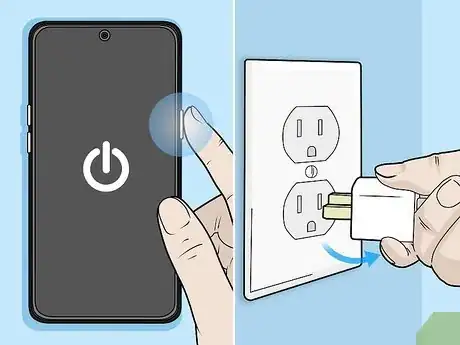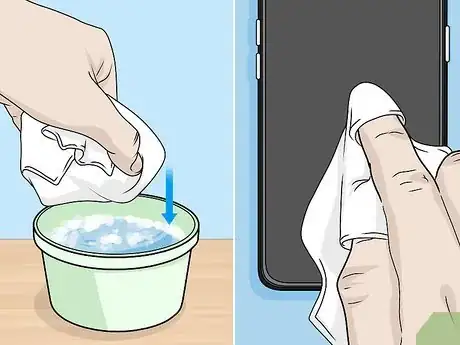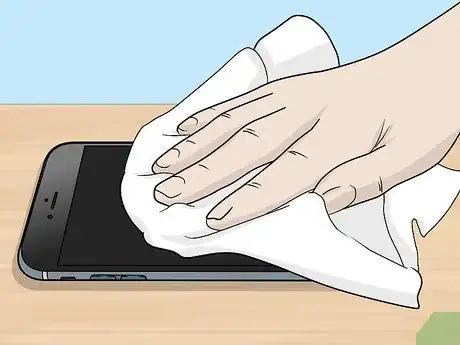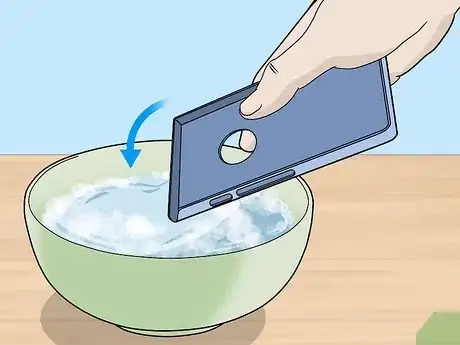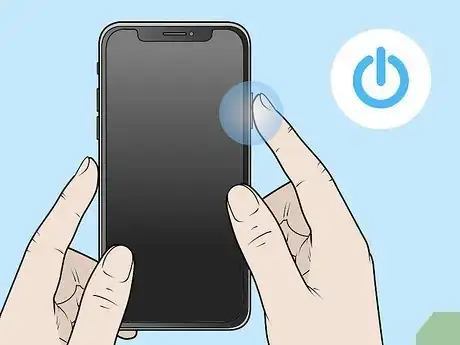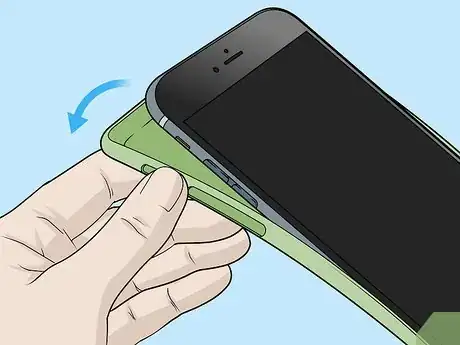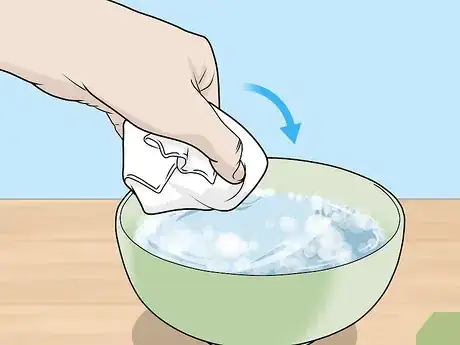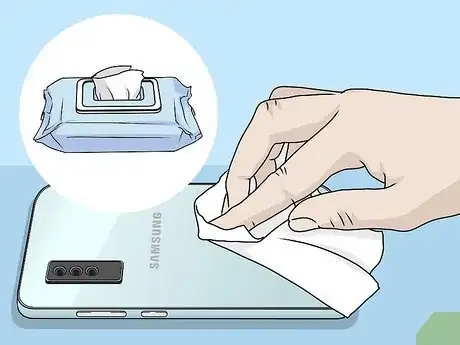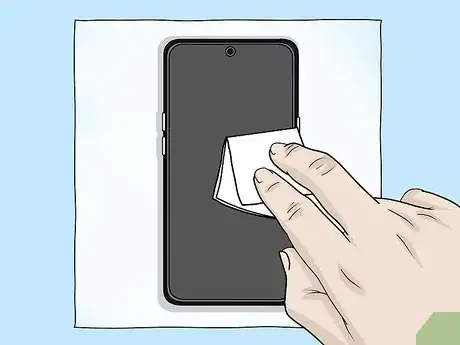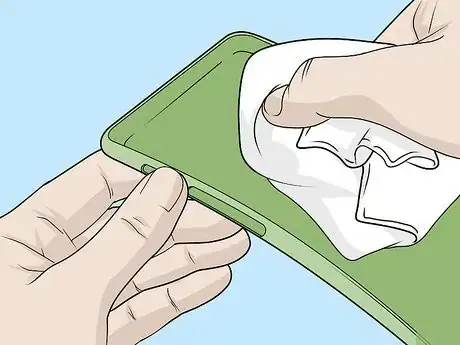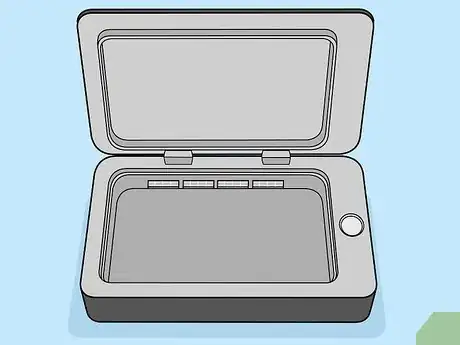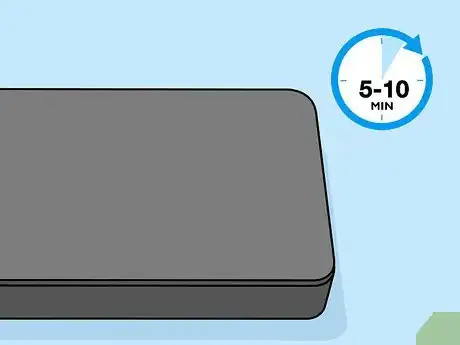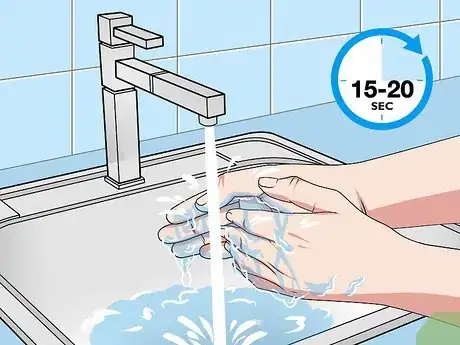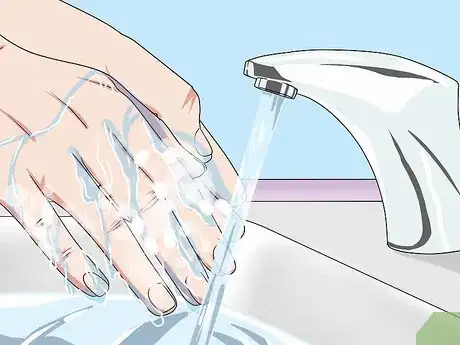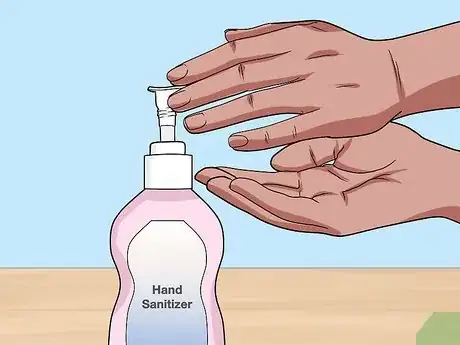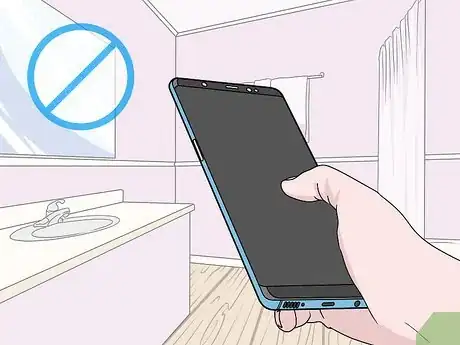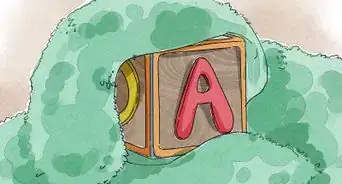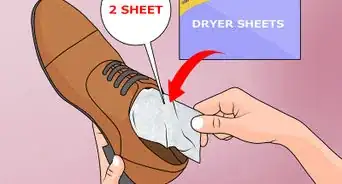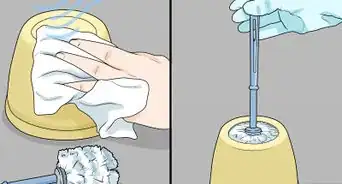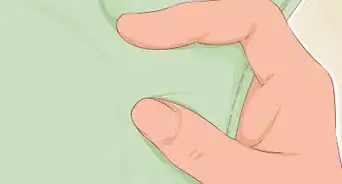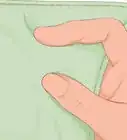This article was medically reviewed by Luba Lee, FNP-BC, MS and by wikiHow staff writer, Hunter Rising. Luba Lee, FNP-BC is a Board-Certified Family Nurse Practitioner (FNP) and educator in Tennessee with over a decade of clinical experience. Luba has certifications in Pediatric Advanced Life Support (PALS), Emergency Medicine, Advanced Cardiac Life Support (ACLS), Team Building, and Critical Care Nursing. She received her Master of Science in Nursing (MSN) from the University of Tennessee in 2006.
There are 10 references cited in this article, which can be found at the bottom of the page.
This article has been viewed 62,744 times.
Phones tend to collect a lot of germs on the surface and these germs can make you or another person sick. For a quick and easy clean, use alcohol prep pads or disinfectant wipes to sanitize your phone. You can also wipe away dirt and grease with a cloth that’s slightly moistened with soap and water. If you're particularly worried about germs or viruses, an alcohol solution is the most effective germ-buster. Keep in mind that alcohol can damage your phone’s screen over time, so don't use it too often, though it's still crucial to disinfect your phone and a screen protector will prevent this issue. A UV light sanitizer is also highly effective, but they can be a bit expensive. Be sure to disinfect your phone regularly to keep it safe and germ-free!
Things You Should Know
- If you’re using any kind of liquid cleaner (including water), turn the phone off and remove the battery, if possible.
- You can disinfect your phone by dampening a lint-free microfiber with soap and water and wiping it down; dry the phone when you’re done with a paper towel or dry microfiber cloth.
- If you want to sanitize the phone, wipe your phone down with a disinfectant wipe.
- You can purchase a UV phone sanitizer to streamline this process in the future; all you do is place it inside of the UV container and let it run for 5-10 minutes.
- Never spray your phone directly with any kind of cleaning spray and always wash your hands with soap and water before you clean it.
Steps
Using Soap and Water for Basic Disinfection
-
1Turn off your phone and disconnect it from the power outlet. Hold down the power button on the side of your phone until you see the shutdown prompt on the screen. Wait for your phone to turn off completely before you begin cleaning it so you’re less likely to damage the internal electronics. If you have your phone plugged into a charger, unplug it while you’re working so you don’t get shocked.
- Avoid disinfecting your phone while it’s turned on since you cause it to short out.
-
2Remove your phone’s case if it has one. Since bacteria can get behind the case, make sure to pop it off while you’re cleaning. If your case comes in multiple pieces, separate them so you’re able to clean each part individually. Keep your phone and case away from each other while you’re cleaning so you don’t infect them again.
- Be careful with your phone when you take it out of the case since it can get damaged more easily.
Advertisement -
3Mix a few drops off dish soap and warm water in a bowl. Fill a small bowl with the warmest water you can handle from your faucet. Add 1–2 drops of dish soap to the water and stir it together until it’s thoroughly combined and sudsy.[1]
- Opt for antibacterial soap if possible since it’s more likely to kill harmful germs.
Variation: You can also use hand soap if you don’t have any dish soap available.
-
4Wet a microfiber cloth with the solution and wring it out completely. Quickly dip your microfiber cloth into the soapy water and pull it out before it gets completely saturated. Squeeze the cloth tightly in your hands to wring out any excess water so you don’t get your phone dripping wet.[2]
- Avoid using paper towels or abrasive cleaning pads since you could scratch your phone’s screen.
-
5Rub the phone's surfaces thoroughly with the cloth to remove germs. Start on your screen and work in circular motions over the entire phone. Work carefully around the microphones, ports, and buttons since water could get trapped inside and ruin the internal electronics. After you finish cleaning the front, turn your phone over and start wiping the back clean.[3]
- If you have a water-resistant phone, it’s okay if you get some water near the ports or buttons since it’s less likely to cause damage.
-
6Dry any remaining moisture on the phone with a clean towel. Set your phone on a dry microfiber cloth and pat the surfaces dry. Be sure to remove all of the water that’s still left on the surface so it’s less likely to cause damage.[4]
-
7Clean rubber or leather phone cases with the soapy water. Dip your microfiber cloth back into the soapy water and wring it out again. Wipe the interior and exterior of your phone case to remove any dirt or dust that’s stuck inside of it. Focus on the corners or any small gaps where bacteria would grow more easily to ensure you completely sanitize the case.
- Avoid submerging your phone case since you could damage the material.
- If you have a leather phone case, use a leather conditioner afterward so the case stays soft.
Killing Germs with Alcohol
-
1Shut off and unplug your phone from the charger. Unplug your phone from any chargers so you don’t get shocked while you’re cleaning. Press the power button on the side of your phone and hold it down until you see a prompt pop up on the screen. Wait for your phone to completely shut down before you start cleaning it.
- If you work on your phone while it’s still turned on, you could cause the electronics to short out.
-
2Pop the phone’s case off and set it aside. Push the edge of the case away from your phone so it comes loose. Pull your phone out and set it aside while you’re working. If your phone case is made up of multiple pieces, take them all apart so you’re able to thoroughly clean them later.
- Keep your case and phone separate while you’re working so you don’t accidentally recontaminate them.
-
3Pour rubbing alcohol onto a microfiber cloth. Opt for rubbing alcohol that has at least 60–70% alcohol content so it effectively kills the most germs. [5]
- Wet the microfiber cloth in your alcohol solution and wring it out to remove any excess liquid which could damage your phone.
- Don’t use paper towels or other abrasive cleaning rags since they could scratch your phone. Lint-free microfiber is best.
Warning: Over time, rubbing alcohol can remove the protective coating on your phone’s screen that keeps your fingerprints from smudging and prevents water damage, so use it sparingly while you’re cleaning.
-
4Wipe the phone’s surfaces from top to bottom with your cloth. Work across the entire front of your phone in circular motions and apply light pressure. Go slowly around the ports, buttons, and speakers so you don’t get your cleaning solution in them since the alcohol could ruin the electronics. Flip your phone over and clean the back side in the same way.[6]
- Wash your hands before you start cleaning your phone so you aren’t recontaminating it right away.
-
5Opt for cleaning wipes if you need to sanitize your phone on the go. Look for wipes specifically designed for cleaning electronics since they’re less likely to damage your phone. Rub the entire phone with the wipe so it’s completely sanitized. Focus on areas that have tight seams or small cracks where bacteria are more likely to build up. Be careful not to put the wipe inside any ports since you could damage the electronics.[7]
- You can buy cleaning wipes for electronics from your local electronics store, and they will usually kill around 99% of the bacteria and viruses on your phone.
- Keep a few cleaning wipes with you whenever you leave so you’re able to disinfect your phone on the go.
-
6Pat your phone dry with a second microfiber cloth. Lay the microfiber cloth flat on your work surface and set your phone down in the middle of it. Gently press the cloth onto your phone to pick up any moisture. Make sure the phone’s completely dry so it doesn’t get damaged.
- You don’t have to dry your phone if you’re using cleaning wipes.
-
7Sanitize wood or plastic phone cases with your alcohol solution. Dip your cloth back in your cleaning solution and wring it out. Wipe the inside and outside of your phone case, making sure to sanitize each piece. Pay extra attention to any small cracks or seams in the case since bacteria can build up there.
- Avoid using alcohol on leather phone cases since you could dry them out.
- If you have trouble cleaning out the crevices, try using a stiff-bristled toothbrush.
Using a UV Light Sanitizer
-
1Buy a UV phone sanitizer online or from an electronics store. Look for a model that’s large enough to completely close around your phone, or else the treatment won’t be as effective. Compare the features and reviews for multiple options so you can choose the one that’s the most affordable for you.
- UV phone sanitizers are small enclosed cases that have UV-C lights that can kill up to 99.9% of the bacteria and viruses on your phone.
- You can buy UV light sanitizers for around $60 USD, but more effective models will usually cost you more.
-
2Put your phone inside the sanitizer and shut the lid. Open the lid for the sanitizer and set your phone face-up in the bottom section. Make sure the phone doesn’t hang over the inset section, or else you won’t be able to close it properly. Slowly lower the sanitizer’s lid to turn on the UV lights and start disinfecting your device.[8]
- You can leave the case on your phone or you may take it off. The UV light will also kill any germs on the case.
- Read the instructions for the sanitizer completely since you may need to do additional steps when you clean your phone.
Tip: Many UV sanitizers have ports so you can plug your phone in so it can charge while you’re cleaning it.
-
3Leave your phone inside the sanitizer for 5–10 minutes. Look for a lit signal light on the outside of the sanitizer so you know that it’s working properly. Keep your phone inside of the case with the lid down so it can effectively kill the germs on the surface. After 5–10 minutes, the signal light will turn off so you know when you can remove your phone.[9]
- The UV lights will turn off automatically if you open the lid at any point while disinfecting your phone.
- If you take your phone out of the sanitizer early, then it may still have some germs left on the surface.
-
4Wash your hands before taking your phone out again. Wet your hands with warm water and lather hand soap for at least 15–20 seconds. Rinse off the soap and dry your hands off before lifting the lid on your UV sanitizer. Take your phone out and use it as normal until the next time you clean it.
- Use hand sanitizer if you aren’t able to wash your hands.
- If you don’t disinfect your hands, then you can contaminate your phone right away when you take it out.
Keeping Your Phone Germ-Free
-
1Wash your hands frequently so germs don’t transfer to your phone. Always use warm water and soap while you’re washing your hands to help kill more bacteria and viruses. Lather the soap on your hands for at least 20 seconds, making sure you clean the backs of your hands, between your fingers, and under your nails. Rinse the soap off with warm water before drying them on a clean towel.[10]
- Be sure to wash your hands before handling or eating food, treating a wound, or caring for someone who’s sick. Then clean your hands after using the bathroom, blowing your nose, or handling garbage.
Warning: Avoid sneezing or coughing into your hands since you’re more likely to spread germs and bacteria.
-
2Use hand sanitizer if you aren’t able to wash your hands. Look for a hand sanitizer that contains at least 60% alcohol so it effectively kills bacteria and viruses. Put a coin-sized amount in your palm and rub your hands together, making sure it reaches between your fingers and under your nails. Keep rubbing the sanitizer in until it completely absorbs into your skin.[11]
- Hand sanitizer may not kill all germs on your hands.
- If you have the option, wash your hands instead since it will disinfect your hands more thoroughly.
-
3Use headphones to keep your phone away from your face. Opt for headphones that have a built-in microphone so you’re still able to answer phone calls. Keep your phone in your pocket or on your desk throughout the day so you don’t have to handle it as often. Whenever you take a phone call, put in your headphones so you don’t have to bring the screen near your face.[12]
- If you don’t have headphones, hold your phone away from your mouth or use speakerphone to help reduce the spread of germs.
-
4Avoid handling your phone in the bathroom. Leave your phone in another room whenever you go to the bathroom. If you have to bring your phone with you, keep it enclosed in a pocket or bag the entire time. Don’t touch your phone until you’re finished in the bathroom and have washed your hands thoroughly.[13]
Expert Q&A
-
QuestionWhat can I use to sanitize my phone?
 Jonathan TavarezJonathan Tavarez is the Founder of Pro Housekeepers, a premium cleaning service headquartered in Tampa, Florida catering to residential and commercial clients across the United States. Since 2015, Pro Housekeepers uses rigorous training methodologies to ensure high quality cleaning standards. Jonathan has over five years of professional cleaning experience and has over two years of experience as the Communications Director for the United Nations Association Tampa Bay. Jonathan earned a BS in Management and Marketing from the University of South Florida in 2012.
Jonathan TavarezJonathan Tavarez is the Founder of Pro Housekeepers, a premium cleaning service headquartered in Tampa, Florida catering to residential and commercial clients across the United States. Since 2015, Pro Housekeepers uses rigorous training methodologies to ensure high quality cleaning standards. Jonathan has over five years of professional cleaning experience and has over two years of experience as the Communications Director for the United Nations Association Tampa Bay. Jonathan earned a BS in Management and Marketing from the University of South Florida in 2012.
Property Hygiene Enabler Alcohol wipes can sanitize your phone screen and case, but avoid using anything like vodka, vinegar, or ammonia, as these aren't recognized as effective disinfectants by the World Health Organization. Also, a regular UV light will not sterilize surfaces.
Alcohol wipes can sanitize your phone screen and case, but avoid using anything like vodka, vinegar, or ammonia, as these aren't recognized as effective disinfectants by the World Health Organization. Also, a regular UV light will not sterilize surfaces.
Warnings
- Use rubbing alcohol sparingly while cleaning your phone since you could remove the protective coating from the screen that keeps it from getting covered in fingerprints.⧼thumbs_response⧽
- Do not use vinegar to disinfect. It is not an EPA registered disinfectant and its efficacy against viruses and bacteria is low (80% and 90%, respectively). It will not kill all germs.⧼thumbs_response⧽
- Avoid touching your face after using your phone so you’re less likely to get sick or spread bacteria and viruses.⧼thumbs_response⧽
Things You’ll Need
Using Soap and Water for Basic Disinfection
- Microfiber cloths
- Dish or hand soap
- Bowl
Killing Germs with Alcohol
- Rubbing alcohol
- Bowl
- Cleaning wipes for electronics
- Microfiber cloths
Using a UV Light Sanitizer
- UV light sanitizer
- All-purpose disinfectant
- Hand soap
References
- ↑ https://www.cnbc.com/2020/03/04/how-to-clean-your-phone-to-help-stop-the-spread-of-germs.html
- ↑ https://www.theguardian.com/lifeandstyle/2020/mar/22/coronavirus-free-how-to-clean-your-mobile-phone
- ↑ https://www.theguardian.com/lifeandstyle/2020/mar/22/coronavirus-free-how-to-clean-your-mobile-phone
- ↑ https://www.theguardian.com/lifeandstyle/2020/mar/22/coronavirus-free-how-to-clean-your-mobile-phone
- ↑ https://www.cnbc.com/2020/03/04/how-to-clean-your-phone-to-help-stop-the-spread-of-germs.html
- ↑ https://www.cnbc.com/2017/03/27/how-to-clean-your-smartphone.html
- ↑ https://www.cnbc.com/2017/03/27/how-to-clean-your-smartphone.html
- ↑ https://www.ncbi.nlm.nih.gov/pmc/articles/PMC5875094/
- ↑ https://www.cnbc.com/2017/03/27/how-to-clean-your-smartphone.html
About This Article
Your phone can carry germs and bacteria that can make you sick, so it’s important to routinely disinfect it. To disinfect your phone, first remove it from its case, turn it off, and make sure it isn’t plugged in. Then, use a disinfectant wipe or alcohol prep pad to wipe down the screen, back, and sides of your phone, avoiding any ports. Do the same thing with your phone case. Let your phone and case air dry. You can also spray a nonabrasive or alcohol-based cleaner on a lint-free cloth and wipe down your phone and case with it. Avoid using harsh cleaners like bleach or pure rubbing alcohol since it can damage the protective coatings on your phone over time.
